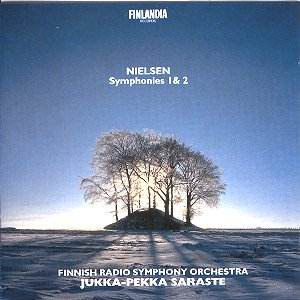I am somewhat puzzled what Finlandia’s release strategy
is with this latest issue in Nielsen’s symphonic cycle. This is the
last disc in the series, with the remainder having been released at
full price, two symphonies per disc. But we have also had the 4th
and 5th Symphonies at budget price on an Ultima double, coupled
with the Clarinet and Flute Concerti plus a couple of small orchestral
pieces, so I wonder if a budget release will be made for the others.
How strange the strategies of the record companies.
Still, no matter, for here we have superb performances
of both these early symphonies which can hold their own with any current
performances, even including those of live recordings by Nielsen’s contemporaries
Erik Tuxen and Launy Grøndahl on Danacord DACOCD 351. No. 2 particularly
is extremely vital, which makes a wonderful change after some other
modern performances, which smooth the contours of these wonderful works.
The overall characteristic in my opinion of these early
symphonies, is that of vitality and both of these performances display
this characteristic to the full.
The Finlandia recording is superb, and the orchestra
is set in a fully believable acoustic. According to the notes, the recording
was done in the Sibelius Hall in Lahti, the new home of the Lahti Symphony
Orchestra. The Finnish Radio Symphony Orchestra has improved in all
departments over the years, and is now a first rate ensemble. Put into
a superb acoustic the improvements are noticeably superior.
The first symphony was written before the composer
had written much else, and given these circumstances, Nielsen’s ability
to create a fully reasoned expertly crafted symphonic argument such
as we have here is incredible. There are not many composers who could
write such a mature symphonic work as this at the first attempt, and
it is we who benefit from the composer’s facility.
We have here a traditional four movement work, with
the slow movement occupying its traditional second place, followed by
an intermezzo and rapid finale. This is not particularly notable – where
Nielsen was at the forefront was in the key structure of the work. The
work starts in C Major, but the first movement is basically in G Minor.
As the work progresses the tonality progresses from G Minor to C Major.
This is similar to what Mahler was experimenting with, and both composers
came to much the same result simultaneously, albeit totally independently.
The second symphony was a further development of the
tonality tried out in the first, and also had a semi-pictorial programme,
the symphony being based on a woodcut which Nielsen had seen in a pub
when out with his wife and friends. This woodcut showed in four pictures,
the four temperaments of man – Choleric, Phlegmatic, Melancholic and
Sanguine. These form the basis and character of the four movements,
and once again Saraste and his orchestra put these characteristics very
clearly in front of us, the lucky listeners.
I would now rate this Nielsen cycle at the top of the
modern cycles. The only criticism could be of a comparative nature concerning
the technical quality of the orchestral playing. For example the standard
of the playing of the San Francisco Symphony Orchestra with Blomstedt
on Decca could be considered to be marginally better. The performances
are just as good – go buy the Finlandia.
John Phillips

![]() Finnish Radio Symphony
Orchestra – Jukka-Pekka Saraste
Finnish Radio Symphony
Orchestra – Jukka-Pekka Saraste ![]() FINLANDIA 8573-85574-2
[63.31]
FINLANDIA 8573-85574-2
[63.31]